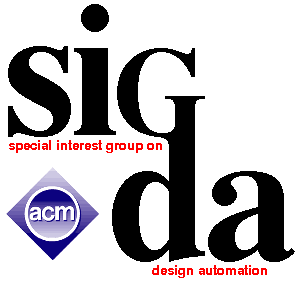
Sponsored by SIGDA
SIGDA Liaison
Prof. Igor Markov
|
|
Problems and References
To download the tar.gz file for all related papers, click here.
Problem 1: Analysis & Circuit Design
Contributed by: Matt Guthaus, University of California Santa Cruz
Overview:
Clock Skew Optimization
Clock Skew Optimization,
John P. Fishburn,
IEEE Transactions on Computers, Vol. 39, No. 7, July 1990
Problem 2: Physical Design
Contributed by: Matt Guthaus, University of California Santa Cruz
Overview:
Iterative Steiner Heuristics
A New Class of Steiner Tree Heuristics with Good Performance: the Iterated
1-Steiner Approach,
Andrew Kahng and Gabriel Robbins,
Proc. IEEE International Conference on Computer-Aided Design, November 1990,
pp. 428-431
Problem 3: Logic & High-Level Synthesis
Contributed by: Marc Riedel, University of Minnesota
Overview:
The Synthesis of Parity Trees
No dedicated paper.
Ample explanation will be provided in the problem statement.
Problem 4: System Design and Analysis
Contributed by: Marc Riedel, University of Minnesota
Overview:
Input-Dependent, Logic-Level Timing Analysis
Timing Analysis of Combinational Circuits Using ADD's,
R. I. Bahar, E. A. Frohm, C. M. Gaona, and G. D. Hachtel,
European Design Automation Conference, 1994
",
Problem 5: Functional Verification
Contributed by: Geert Janssen, IBM Research
Overview:
You are challenged to work with a ZDD package.
[By the way, we will NOT be using CUDD and its EXTRA library.]
Calculation of Unate Cube Set Algebra Using Zero-Suppressed BDDs
,
Shin-ichi Minato,
31th Design Automation Conference, 1994, pp. 420-424
Problem 6: Timing, Test, and Manufacturing
Contributed by: Geert Janssen, IBM Research
Overview:
Apply Hamming code to error recovery and test your solution with a logic
simulator.
Hamming code,
From Wikipedia, the free encyclopedia,
http://en.wikipedia.org/wiki/Hamming_code, 24 October 2006
Computer Platform
During the contest one desktop computer will be available per team.
This will be a Pentium 4 running SuSE Linux. All necessary software and
the problem statements will be pre-installed. Also, in your home directory you
will find a recommended directory structure to organize your work.
|


